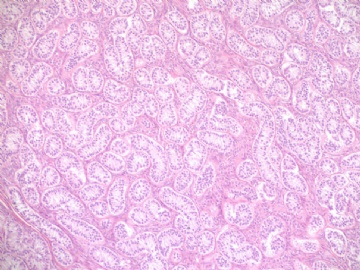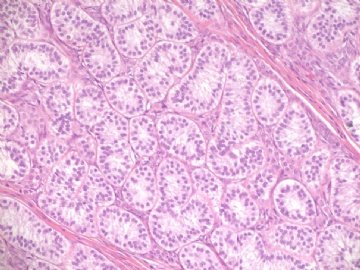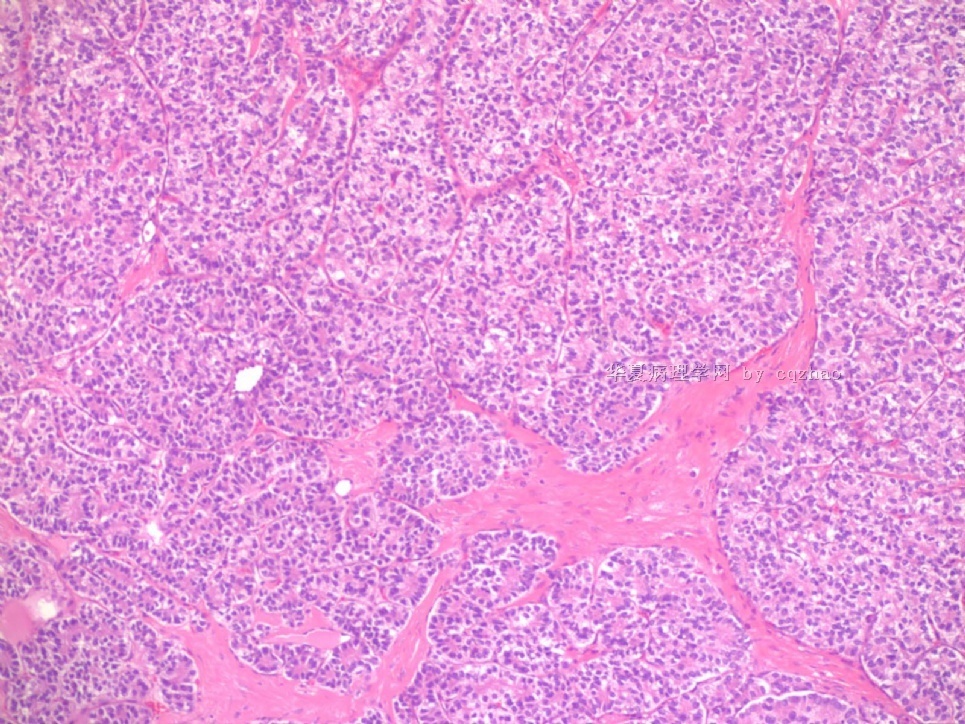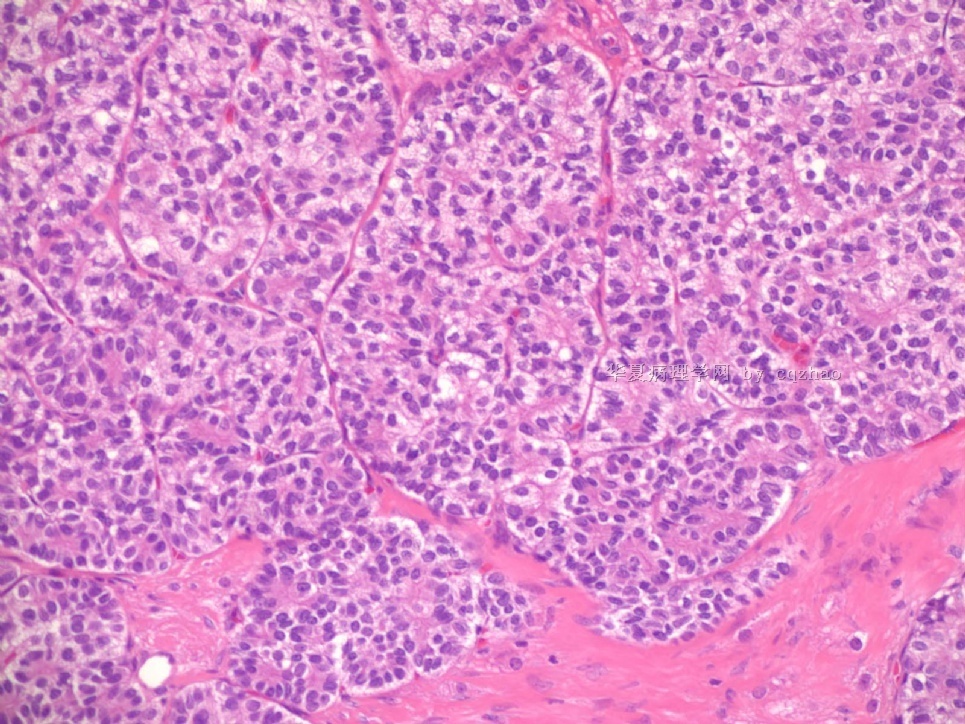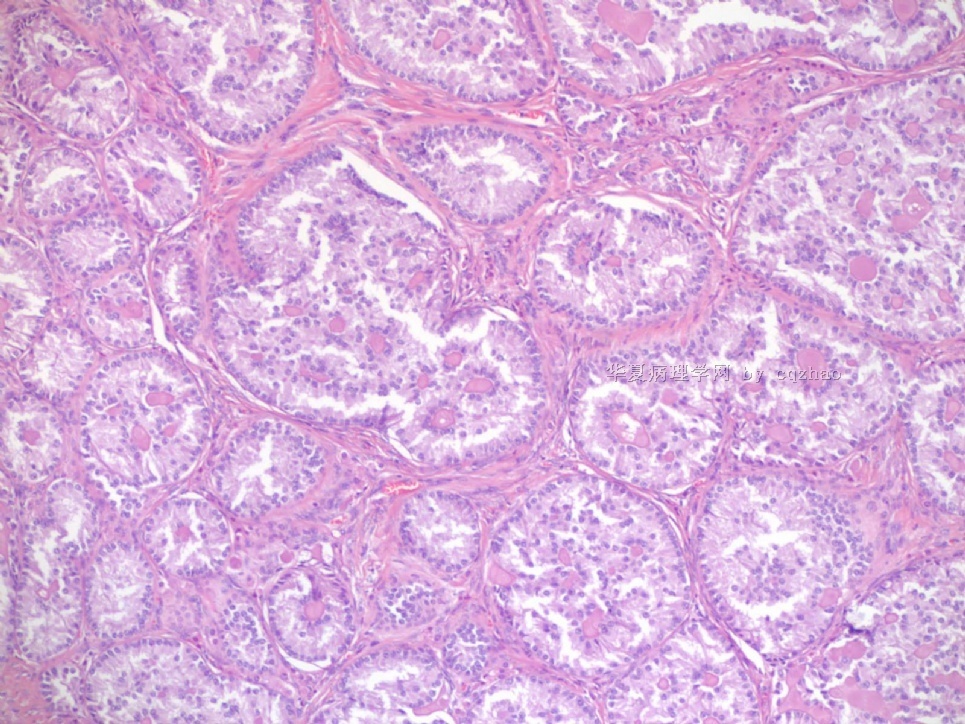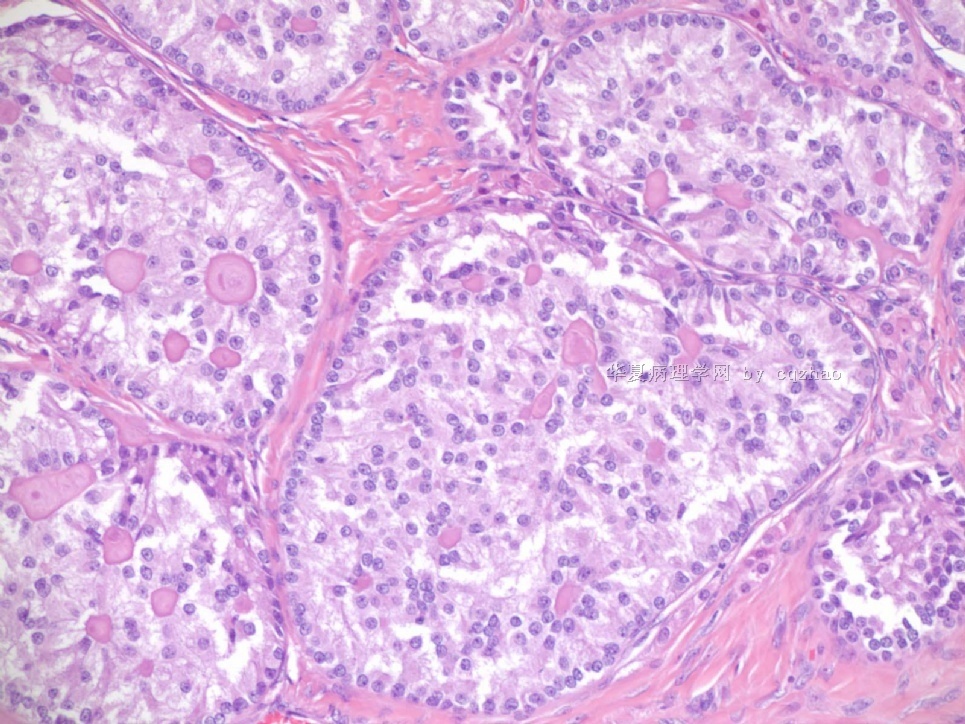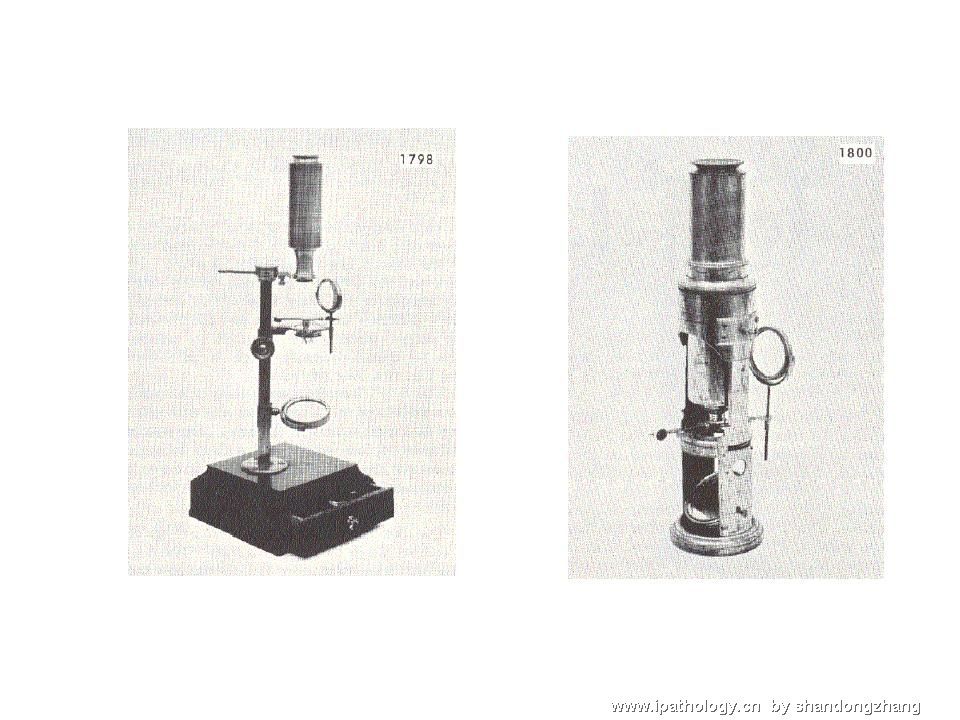| 图片: | |
|---|---|
| 名称: | |
| 描述: | |
- Sharing some photos of ovarian pure sertoli cell tumors
-
Am J Surg Pathol. 2007 Feb;31(2):255-66.
-
Comparative analysis of alternative and traditional immunohistochemical markers for the distinction of ovarian sertoli cell tumor from endometrioid tumors and carcinoid tumor: A study of 160 cases.
Department of Gynecologic and Breast Pathology, Armed Forces Institute of Pathology, Washington, DC, USA. chengquanzhao@yahoo.com
The main neoplasms in the differential diagnosis for primary ovarian tumors with a tubule-rich pattern are pure Sertoli cell tumor, endometrioid tumors (including borderline tumor, well-differentiated carcinoma, and the sertoliform variant of endometrioid carcinoma), and carcinoid tumor. Because traditional immunohistochemical markers [pan-cytokeratin (pan-CK), low molecular weight cytokeratin (CK8/18), epithelial membrane antigen (EMA), inhibin, calretinin, CD99, chromogranin, and synaptophysin] can occasionally have diagnostic limitations, the goal of this study was to determine whether or not any alternative markers [cytokeratin 7 (CK7), estrogen receptor (ER), progesterone receptor (PR), CD10, and CD56] have better diagnostic utility when compared with traditional markers for this differential diagnosis. Immunohistochemical stains for alternative, as well as traditional, markers were performed on the following primary ovarian tumors: pure Sertoli cell tumor (n = 40), endometrioid borderline tumor (n = 38), sertoliform endometrioid carcinoma (n = 13), well-differentiated endometrioid carcinoma (n = 27), and carcinoid tumor (n = 42). Extent and intensity of immunostaining were semiquantitatively scored. In addition, immunohistochemical composite scores (ICSs) in positive cases were calculated on the basis of the combination of extent and intensity scores. Cytokeratin 7 (CK7) was positive in 97% of endometrioid tumors, 13% of Sertoli cell tumors, and 24% of carcinoid tumors. The differences in the mean ICSs for endometrioid tumors versus Sertoli cell tumor or carcinoid tumor were statistically significant (P values ranging from <0.001 to 0.018). ER and PR were positive in 87% and 86% of endometrioid tumors, 8% and 13% of Sertoli cell tumors, and 2% each of carcinoid tumors, respectively. The differences in the mean ICSs for endometrioid tumors versus Sertoli cell tumor were statistically significant (P values ranging from <0.001 to 0.012). Among the epithelial markers, EMA seemed to be the most discriminatory but only slightly better than CK7, ER, or PR. Pan-CK and CK8/18 were not helpful. CD10 showed overlapping patterns of expression in all categories of tumors. Among the sex cord markers, CD10 was markedly less useful than inhibin or calretinin; CD99 was not discriminatory. CD56 showed overlapping patterns of expression in all categories of tumors. Among the neuroendocrine markers, CD56 was less useful than chromogranin or synaptophysin. When traditional immunohistochemical markers are problematic for the differential diagnosis of ovarian Sertoli cell tumor versus endometrioid tumors versus carcinoid tumor, adding CK7, ER, and/or PR to a panel of markers can be helpful. Endometrioid tumors more frequently express CK7, ER, and PR and show a greater extent of immunostaining in contrast to Sertoli cell tumor and carcinoid tumor. Compared with traditional epithelial markers, CK7, ER, and PR are nearly as advantageous as EMA. Inhibin is the most discriminatory sex cord marker, and CD10 is not helpful in the differential diagnosis. Chromogranin and synaptophysin are excellent discriminatory markers for carcinoid tumor, and CD56 is neither sufficiently sensitive nor specific enough for this differential diagnosis to warrant its use in routine practice.
-
卵巢性索细胞瘤是很少见的,并且他们的形态学、行为、愈后也是不明确的。它们类似许多不同的肿瘤,但更多的是性索细胞细胞瘤,免疫组化有助于诊断,但在大多数情况下意义不大。我们研究54例的临床病理特征的性索细胞肿瘤,其中免疫组织化学的23人。其中6人患有Peutz-Jeghers综合症(PJS)又称黑斑息肉综合征,年龄从2 - 76岁(平均30岁)。11例患者有雌激素表达现象,4例有雄激素表达现象。肿瘤从0.8至30厘米,多数是在4 - 12厘米。他们都是单个的,通常是实性的,并且经常黄色。镜下主要表现是管状,虽然往往只是局部表现,其它表现为索状、梁状,弥漫状(21例),假乳头状(4例),网状(3例)、岛屿或肺泡状(3例),梭状(3例)。这些管状可以是实心的也可时空心的,但实心的更多见。肿瘤大多数区域有明显的纤维隔分隔,间质丰富,其中15个肿瘤中,,4个有硬化倾向。。这些细胞通常染色较淡,有时可见许多嗜酸性胞浆,6例肿瘤可见大量的胞浆透亮的细胞,类似于富有脂质的支持细胞肿瘤,其中一例细胞具有非泡沫胞浆。44例属于一期(其中42例属于1-2期),1例是2期,3例是3期。6例不足以分期。下面是1期27各病人的随访,所有患者均生存良好,除了2个Ia期和1个Ic期以外,这三个患者在最初诊断后分别在18个月、36个月、9个月后复发,其中2个患者发现有细胞异型,核分裂活跃(10个高倍视野大于5个)其中一个有肿瘤细胞坏死。在具有5年生存期的I期的10个患者中,仅有3例>5 个核分裂/10 HPFs,没有细胞异型及坏死。3个III期患者中,2例随访,1例存活了16个月,另1例在初诊后2年发生了脾转移。他们均有细胞异型,核分裂活跃。23例肿瘤中15例AE1/3-Cam5.2 阳性,所有肿瘤中EMA阴性,22例中18例抑制素阳性,20例中10例钙网膜蛋白阳性,22例中19例 CD99阳性,17/18vimentin+,4/18平滑肌动蛋白+,8/16神经性特异稀醇化酶+,2/20S-100+,所有21例中嗜铬粒蛋白-。虽然性索细胞细胞瘤具有典型的管状结构有利于诊断,但是其他形式也偶尔占主要地位,造成卵巢肿瘤原发和转移上的诊断混乱,EMA, inhibin, and chromogranin有助于排除两种类似性索细胞细胞瘤,(子宫内膜样癌[inhibin-; EMA+; chromogranin-] 和类癌[inhibin-; EMA+; chromogranin+]).虽然CD99和calretinin在这些肿瘤中表达,但在鉴别诊断上是不具有特异性。大多数性索细胞瘤是I期的,单个,细胞异型不大,临床上表现为良性,。但偶有是高期别的。大约有11%的I期有较复杂的组织学结构易造成错误的诊断。性索细胞瘤大多发生在年轻的女性,有时在幼年时有性早熟,偶尔有Peutz-Jeghers综合症
-
cqzhao老师回复:
以上都是支持细胞瘤,是我从AFIP的存档中找出来的,我曾经做过免疫组化(每一例都做了20种左右的染色)。在AFIP的时候我曾经复习了150例的SCT病例,40例做了免疫组化。
对于第四例有人认为是性索间质肿瘤伴环状小管(SCTAT),但是也有称作SCT,复杂管状型(Tavassoli)。其实二者可能是对相同的肿瘤不同作者的不同叫法。认为是SCTAT的可能将之与Peutz-Jeghers综合症联系起来了。实际上Dr。Young的文章发现有11%(6/54)的SCT患者具有该综合症。
第五例是SCT,梭形细胞样生长的组织结构。如果仔细观察的话还是可以看到管状的结构的。
以下是相关文献,有意者自译

- 赚点散碎银子养家,乐呵呵的穿衣吃饭
For the last case, please observe the cytomorphology and architectures of the tumor more carefully. Did you notice some compacted tubular structures? Did you see granulosa tumors like this one before?
I can tell you that all these tumors are ov sex cord tumors. Just think a little more and give the reasonable guess. Frankly speaking rare people in the world have seen this growth pattern of the tumor. Now you are one of them.
-
本帖最后由 于 2009-07-27 22:59:00 编辑
|
For the last case, please observe the cytomorphology and architectures of the tumor more carefully. Did you notice some compacted tubular structures? Did you see granulosa tumors like this one before? I can tell you that all these tumors are ov sex cord tumors. Just think a little more and give the reasonable guess. Frankly speaking rare people in the world have seen this growth pattern of the tumor. Now you are one of them. |
cqzhao老师回复:最后一例,注意仔细观察其细胞形态和肿瘤结构。看到那些比较紧密的管状结构了吗?以前看到过这样的粒层细胞瘤吗?
可以告诉大家的是,这几个病例都是卵巢的性索细胞肿瘤。仔细考虑一下,给出reasonable guess。老实说,看到具有这样的生长方式的这种肿瘤的人不多 (the fifth case)。现在你们就是其中之一……

- 赚点散碎银子养家,乐呵呵的穿衣吃饭
-
本帖最后由 城北 于 2017-02-25 10:18:06 编辑
All of them are pure sertoli cell tumors (SCT) from AFIP files I once used them for IHC study (about 20 stains for each cases). I reviewed 150 cases of pure SCT and used 40 cases for IHC study at AFIP.
As some of you mentioned the case 4 may be called sex cord tumor with annular tubules (SCTAT). Some people may call SCT, complex tubular pattern (Tavassoli). Basically they are the same tumors called different tumors by different authours. People though SCTAT may be related with Peutz-Jeghers syndroma (P-Z-S). In fact Dr. Young paper indicated 11% (6/54)of SCT patients had PJS.
Case 5 is SCT with spindle cell growth pattern. You will appreciate the tubular structure if you see the photos carefully.
Dr. Young paper: Among 54 SCT, The predominant microscopic pattern was tubular, seen, albeit often only focally, in all tumors; other patterns were cords or trabeculae (28), diffuse (21), pseudopapillary (4), retiform (3), islands or alveolar arrangements (3), and spindled (3). The tubules were solid or hollow with the former being somewhat more common.
Remeber that tubular structures are present in all SCT even though they can be very focal.
The largest and best paper about morphogolgic description and clinical followup results of SCT is Dr Young's paper.
The largest and detailed IHC studies on SCT are my two papers. I paste these three papers in the following for some ones who may be interested.
